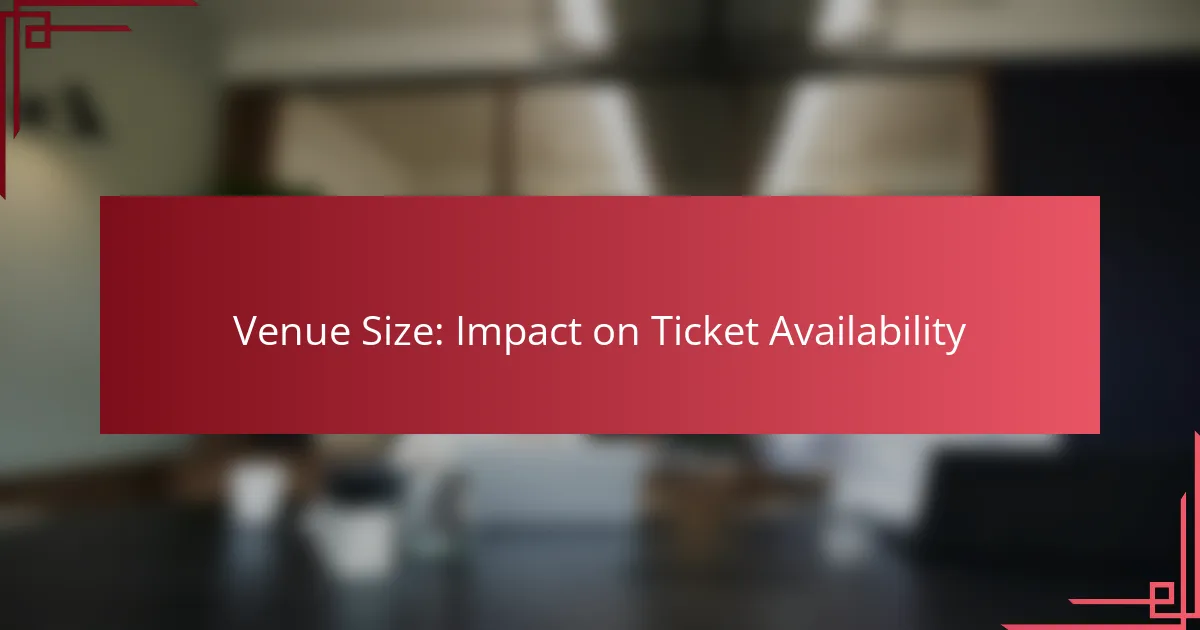Venue size plays a crucial role in determining ticket availability, as smaller venues limit the number of tickets while larger venues can accommodate more attendees, resulting in heightened competition. This understanding is vital for both event organizers and attendees, especially in bustling urban areas where popular events can sell out quickly. Factors such as the type of event, anticipated audience size, and venue accessibility further influence the selection of an appropriate venue to optimize ticket distribution.
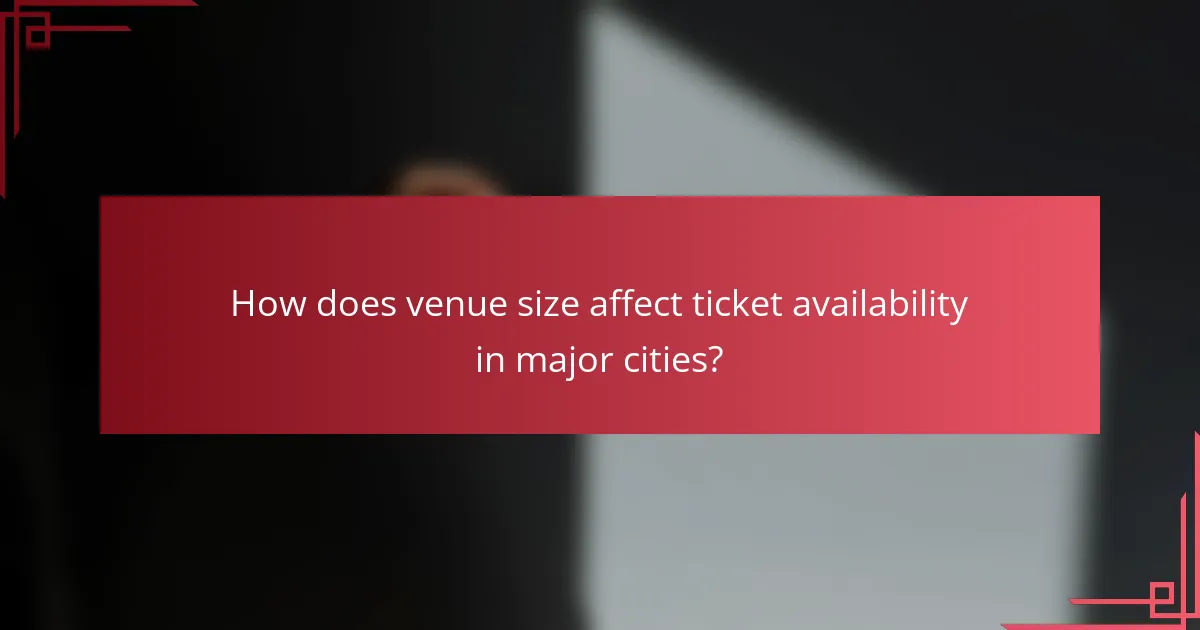
How does venue size affect ticket availability in major cities?
Venue size significantly impacts ticket availability, as smaller venues typically offer fewer tickets, while larger venues can accommodate more attendees, leading to increased competition for those tickets. Understanding this dynamic is essential for both event organizers and attendees in major cities.
Smaller venues limit ticket supply
Smaller venues often have a limited capacity, which directly restricts the number of tickets available for purchase. For instance, a venue that holds a few hundred people may only release a couple of hundred tickets, making it challenging for fans to secure a spot.
This scarcity can drive up demand and ticket prices, especially for popular events. Attendees should be prepared to act quickly when tickets go on sale, as they can sell out within minutes.
Larger venues increase ticket competition
Larger venues can host thousands of attendees, which generally means more tickets are available. However, this increased supply often leads to heightened competition among fans. For example, a stadium concert may have tens of thousands of tickets, but the demand can still exceed supply, resulting in a rush to purchase.
When attending events at larger venues, it’s advisable to use multiple platforms for ticket purchases and consider signing up for alerts. This strategy can help increase the chances of obtaining tickets before they sell out.
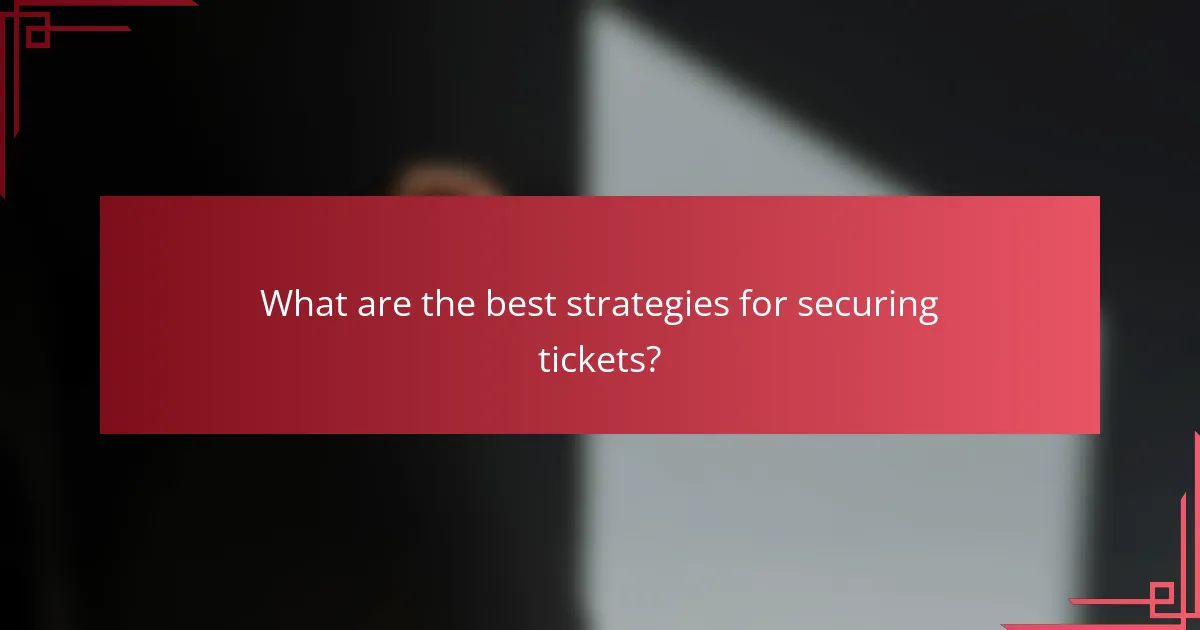
What are the best strategies for securing tickets?
Securing tickets can be challenging, especially for popular events. The best strategies include purchasing pre-sale tickets and utilizing ticket resale platforms to increase your chances of getting a seat.
Purchase pre-sale tickets
Pre-sale tickets are often available before the general public, giving you an advantage in securing your spot. These tickets can be accessed through various means, such as fan clubs, credit card promotions, or venue newsletters.
To maximize your chances, sign up for notifications from your favorite artists or venues. Be ready to act quickly when pre-sale opportunities arise, as these tickets can sell out in minutes.
Utilize ticket resale platforms
Ticket resale platforms allow fans to buy and sell tickets, often at market-driven prices. Websites like StubHub, Viagogo, and SeatGeek can provide access to tickets that may be sold out through official channels.
When using resale platforms, compare prices and check the seller’s ratings to avoid scams. Be aware that resale prices can vary significantly, sometimes exceeding the original ticket price by a considerable margin, especially for high-demand events.
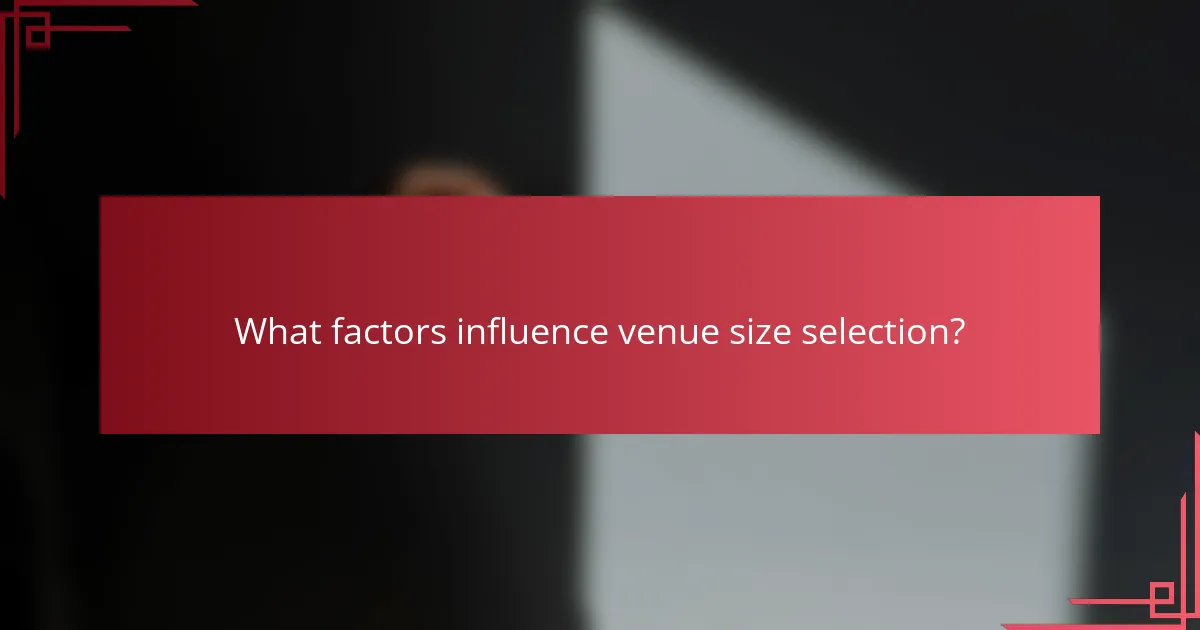
What factors influence venue size selection?
Venue size selection is influenced by various factors including the type of event, expected audience size, location, and accessibility. These elements play a crucial role in ensuring that the venue can accommodate attendees comfortably while maximizing ticket availability.
Event type and audience size
The type of event significantly impacts the required venue size. For instance, concerts and large conventions typically need larger spaces to accommodate thousands of attendees, while workshops or intimate gatherings may only require smaller venues. Understanding the expected audience size helps in selecting a venue that meets both capacity and comfort needs.
When planning an event, consider the nature of the activities involved. For example, seated events like theater performances often require more space per person compared to standing events like music festivals. A rough guideline is to allow 1.5 to 2 square meters per person for seated events and around 0.5 to 1 square meter for standing events.
Location and accessibility
Location plays a pivotal role in venue size selection, as it affects attendance rates. Venues situated in urban areas with good public transport links tend to attract larger crowds. Conversely, remote locations may limit accessibility, necessitating smaller venues to match the expected turnout.
Accessibility features, such as parking availability and compliance with regulations like the Americans with Disabilities Act (ADA), also influence venue choice. Ensure that the venue can accommodate all attendees, including those with mobility challenges, to enhance overall attendance and satisfaction.
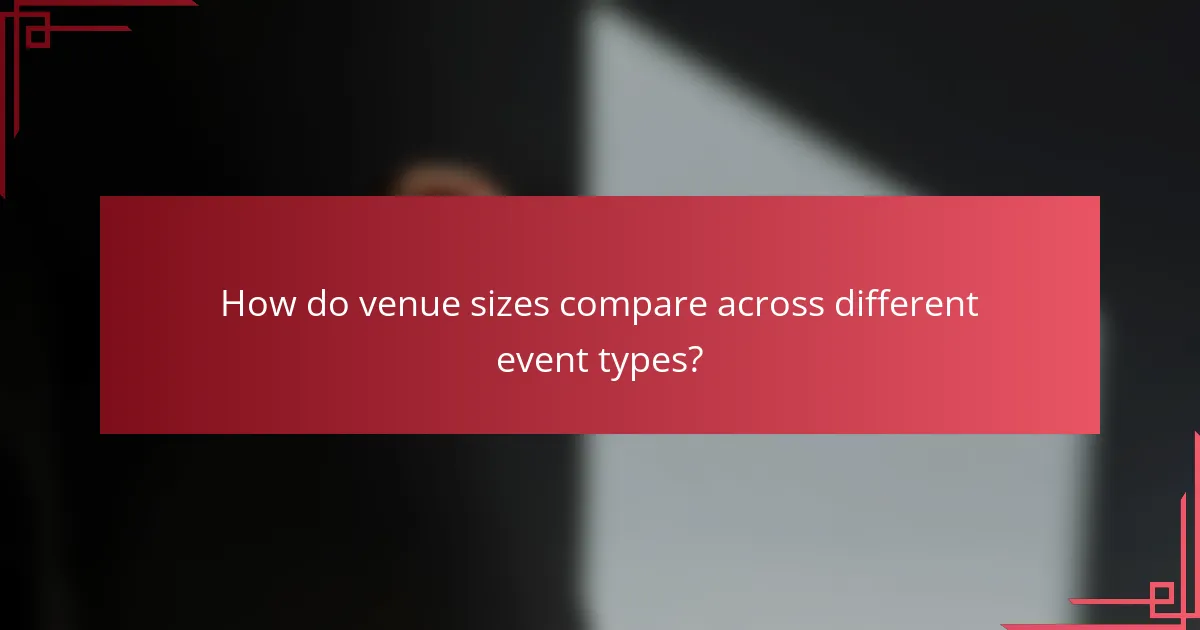
How do venue sizes compare across different event types?
Venue sizes vary significantly depending on the type of event, impacting ticket availability and audience experience. Larger venues like sports arenas can accommodate thousands, while smaller concert halls or theaters may host only a few hundred attendees.
Concert venues vs. sports arenas
Concert venues typically range from intimate settings with a few hundred seats to larger arenas that can hold several thousand fans. Sports arenas are generally designed for a larger audience, often accommodating 10,000 to 20,000 spectators, depending on the sport and configuration.
When planning an event, consider the venue’s capacity and layout. For concerts, a smaller venue can create a more personal experience, while larger arenas may offer better production capabilities and amenities. However, ticket availability can be more limited in smaller venues, impacting demand.
Theater spaces vs. convention centers
Theater spaces usually have fixed seating and are designed for performances, accommodating anywhere from a few dozen to over a thousand attendees. In contrast, convention centers are versatile spaces that can host large gatherings, exhibitions, and conferences, often accommodating several thousand people in a flexible layout.
Choosing between a theater and a convention center depends on the event’s nature. Theaters provide a more focused atmosphere for performances, while convention centers offer greater flexibility for large-scale events. Be mindful of ticket pricing and availability, as larger venues may lead to lower per-ticket costs but higher overall attendance.
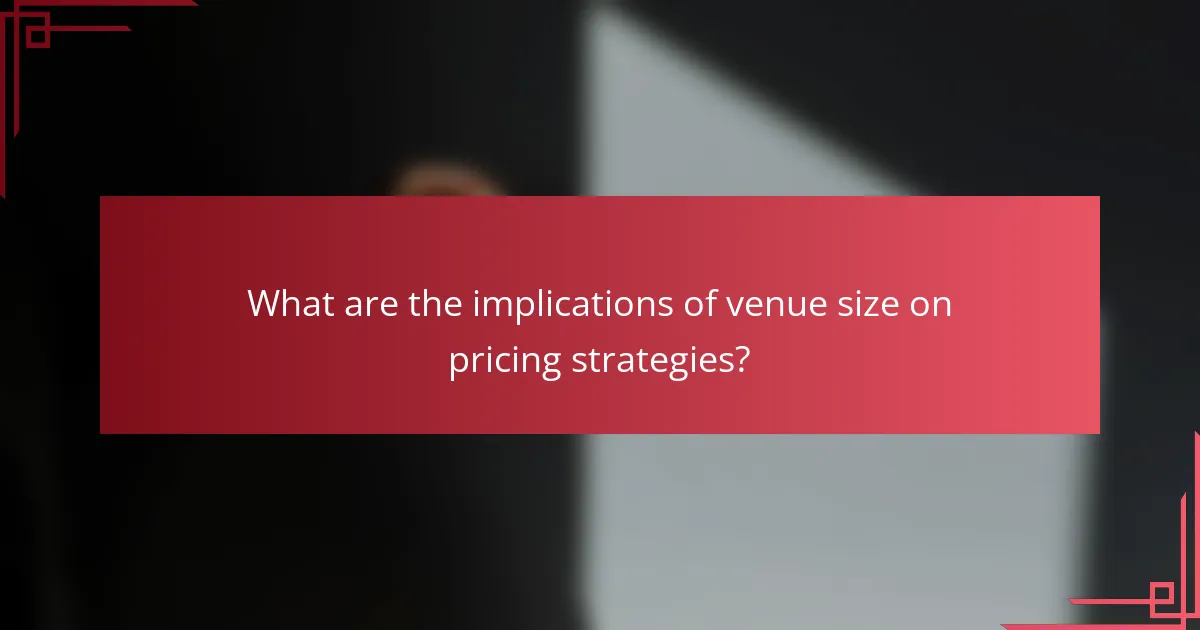
What are the implications of venue size on pricing strategies?
Venue size significantly influences pricing strategies due to variations in ticket availability and demand dynamics. Larger venues often adopt dynamic pricing models to maximize revenue, while smaller venues typically rely on fixed pricing to ensure affordability and consistent sales.
Dynamic pricing in larger venues
Larger venues frequently implement dynamic pricing, adjusting ticket prices based on real-time demand and availability. This approach allows them to capitalize on high demand by increasing prices as the event date approaches or as tickets sell out.
For instance, a concert in a stadium may see ticket prices rise from a base rate of around $50 to over $150 as the event nears and fewer seats remain. This strategy can lead to increased overall revenue but may alienate some potential attendees who find the prices prohibitive.
Fixed pricing in smaller venues
In contrast, smaller venues often utilize fixed pricing strategies to attract a steady stream of customers. By setting a consistent price point, they can appeal to a broader audience and encourage early ticket purchases.
For example, a local theater might charge a flat rate of $20 for all seats, making it accessible to more patrons. This approach helps maintain a reliable attendance rate but may limit revenue potential during peak demand periods.

What trends are emerging in venue size and ticketing?
Emerging trends in venue size and ticketing reflect a shift towards more flexible and hybrid event models. As organizers adapt to changing audience preferences, the interplay between physical and virtual attendance is reshaping how venues are utilized and how tickets are allocated.
Hybrid events and venue flexibility
Hybrid events combine in-person and virtual attendance, allowing for greater flexibility in venue size. Organizers can choose smaller venues for live audiences while accommodating larger online audiences, which can enhance ticket availability and reach.
When planning hybrid events, consider the technological requirements for streaming and interaction. Venues equipped with high-quality audio-visual systems can facilitate a seamless experience for both in-person and virtual attendees, maximizing engagement.
Impact of virtual attendance on venue size
The rise of virtual attendance has led to a reevaluation of venue size requirements. Many events can now operate successfully with reduced physical capacity, as online participants can fill the gap, allowing for more efficient use of space and resources.
For instance, instead of hosting thousands in a large arena, organizers might opt for a smaller venue that accommodates a few hundred attendees while streaming to thousands online. This approach not only lowers costs but also increases ticket availability for those who prefer to attend virtually.
